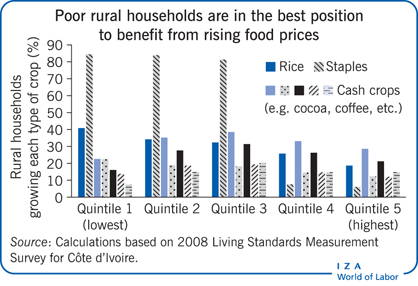Elevator pitch
Dramatic food price spikes in recent years have stimulated debate on the welfare implications of food price risk. According to the Food and Agriculture Organization of the United Nations, the number of undernourished people in sub-Saharan Africa rose to a record 265 million in 2009. There is a gradually developing policy consensus in favor of income redistribution to the poor in developing countries hit by the food price crisis. This recommendation makes sense when the poor are net food consumers, but it ignores the possibility that some poor people are net producers of food and so are likely to benefit from rising food prices.

Key findings
Pros
Rising food prices are likely to alleviate poverty and inequality in areas where poor people are net food producers (produce more food than they consume).
Rising food prices are likely to be welfare-enhancing in areas where women are farmers, because female spending patterns tend to be more child-friendly.
When rising food prices stimulate food production, they may generate new jobs (and related income) that can improve welfare.
The urban middle class relies on non-agricultural employment for its livelihood and so is likely to be more affected by rising food prices than the poorest population segments.
Cons
Rising food prices can exacerbate poverty and inequality when the poor are net food consumers (consume more food than they produce) and there are few non-farm jobs.
The welfare implications of rising food prices are ambiguous—even if women are farmers—if complementary resources for crop commercialization are scarce.
Analyses often disregard the possibility of behavioral changes in response to price shocks, e.g. substituting less expensive foods for more expensive ones.
Rising food prices can exacerbate poverty in the long term when domestic institutional constraints, the international agricultural trade environment, and weather and climate conditions constrain the use of modern high-yielding farming techniques.